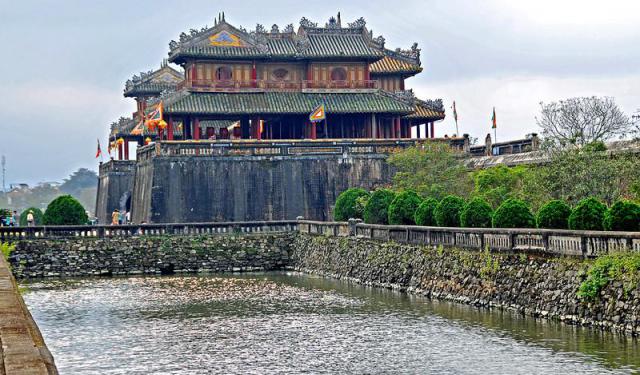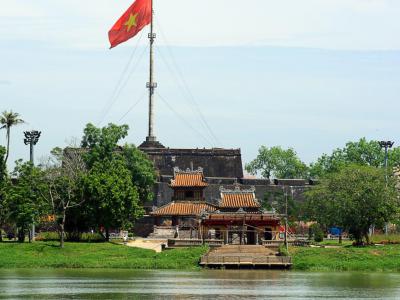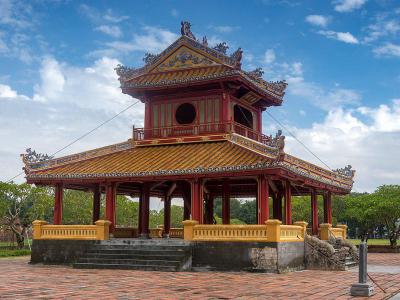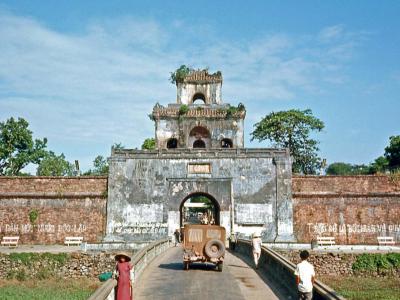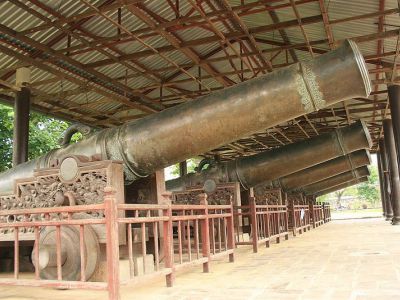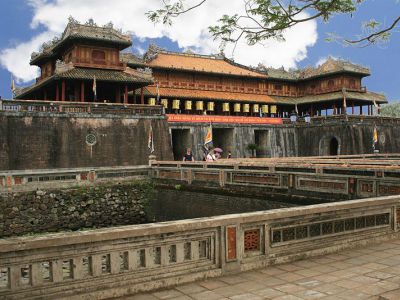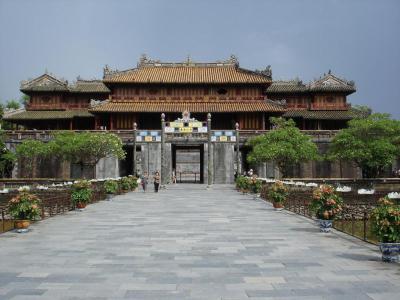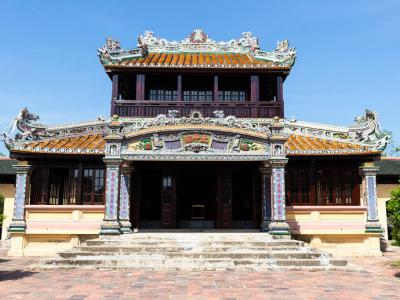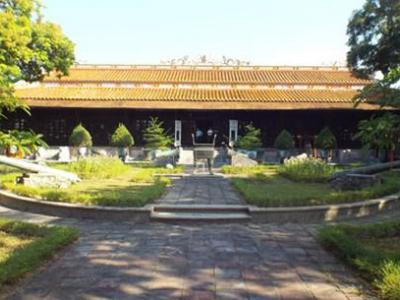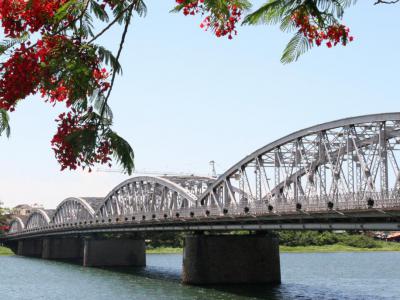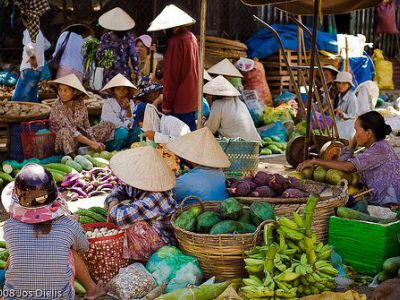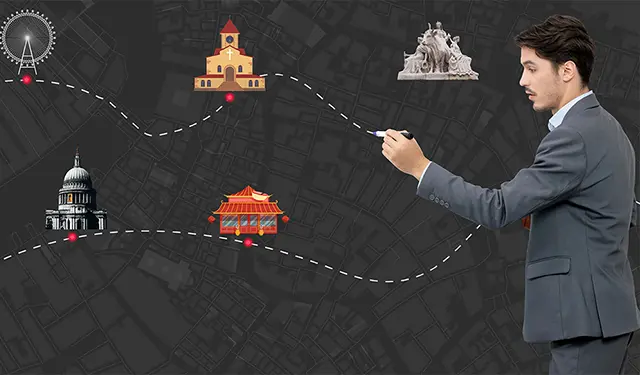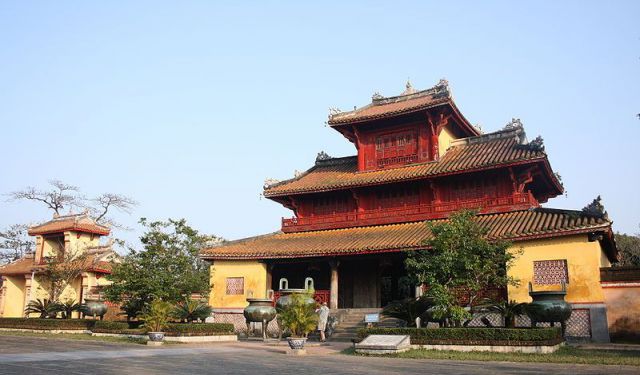Hue Introduction Walking Tour (Self Guided), Hue
Once the seat of the imperial dynasty in the heart of Vietnam, Hue is chock-full of stories. During feudal times, for nearly 150 years – from 1802 to 1945, the city served as the national capital. The royal lifestyle and customs have had a strong impact on the lifestyle of locals, and this impact can still be felt today.
First cited about 200 BCE as the seat of the Chinese military authority in the kingdom of Nam Viet, Hue was captured repeatedly by the Chinese until in 1306 it was ceded to Dai Viet (Vietnam). From 1558, the city was the seat of the Nguyen imperial family.
During the French colonial period, in the second half of the 19th century, Hue was part of the Annam protectorate, and later, under Japanese occupation, from 1940 to 1945, became the seat of a provisional administrative committee of non-communist Vietnamese. In 1949, the newly-declared state of Vietnam chose Saigon as their capital, and thus Hue lost its historic function.
Since the end of World War II, the city endured several upheavals, suffering early damage during the First Indochina War (1946–54), followed by severe civil disturbances in 1963 and again in 1965. During the 1968 Tet Offensive of the Vietnam War, many of the former royal buildings were damaged, but subsequently rebuilt.
In recent years, millions of people have visited the city annually, attracted by its numerous historic monuments, some of which still undergo restoration. Among the most prominent ones, worth checking out, are the Luong Dinh Welcome Pavilion and the Cửa Quảng Đức gate in the western part of the Imperial City. Another famous landmark and a symbol of the Nguyen Dynasty’s grandeur is the Cửu Vị Thần Công (Nine Holy Cannons).
The Palace of Supreme Harmony – Điện Thái Hoà – is situated just behind the Cửa Ngọ Môn gate in the most important court of the Citadel. Outside the fortress, straddling the river, is the Truong Tien Bridge, a distinctive symbol of Hue. And if you want to try some of the most delicious street food in town, make sure not to miss the Đông Ba market.
To get the maximum of your stay in Hue and discover its beautiful locations, take this self-guided walking tour.
First cited about 200 BCE as the seat of the Chinese military authority in the kingdom of Nam Viet, Hue was captured repeatedly by the Chinese until in 1306 it was ceded to Dai Viet (Vietnam). From 1558, the city was the seat of the Nguyen imperial family.
During the French colonial period, in the second half of the 19th century, Hue was part of the Annam protectorate, and later, under Japanese occupation, from 1940 to 1945, became the seat of a provisional administrative committee of non-communist Vietnamese. In 1949, the newly-declared state of Vietnam chose Saigon as their capital, and thus Hue lost its historic function.
Since the end of World War II, the city endured several upheavals, suffering early damage during the First Indochina War (1946–54), followed by severe civil disturbances in 1963 and again in 1965. During the 1968 Tet Offensive of the Vietnam War, many of the former royal buildings were damaged, but subsequently rebuilt.
In recent years, millions of people have visited the city annually, attracted by its numerous historic monuments, some of which still undergo restoration. Among the most prominent ones, worth checking out, are the Luong Dinh Welcome Pavilion and the Cửa Quảng Đức gate in the western part of the Imperial City. Another famous landmark and a symbol of the Nguyen Dynasty’s grandeur is the Cửu Vị Thần Công (Nine Holy Cannons).
The Palace of Supreme Harmony – Điện Thái Hoà – is situated just behind the Cửa Ngọ Môn gate in the most important court of the Citadel. Outside the fortress, straddling the river, is the Truong Tien Bridge, a distinctive symbol of Hue. And if you want to try some of the most delicious street food in town, make sure not to miss the Đông Ba market.
To get the maximum of your stay in Hue and discover its beautiful locations, take this self-guided walking tour.
How it works: Download the app "GPSmyCity: Walks in 1K+ Cities" from Apple App Store or Google Play Store to your mobile phone or tablet. The app turns your mobile device into a personal tour guide and its built-in GPS navigation functions guide you from one tour stop to next. The app works offline, so no data plan is needed when traveling abroad.
Hue Introduction Walking Tour Map
Guide Name: Hue Introduction Walking Tour
Guide Location: Vietnam » Hue (See other walking tours in Hue)
Guide Type: Self-guided Walking Tour (Sightseeing)
# of Attractions: 10
Tour Duration: 2 Hour(s)
Travel Distance: 3.5 Km or 2.2 Miles
Author: DanaOffice
Sight(s) Featured in This Guide:
Guide Location: Vietnam » Hue (See other walking tours in Hue)
Guide Type: Self-guided Walking Tour (Sightseeing)
# of Attractions: 10
Tour Duration: 2 Hour(s)
Travel Distance: 3.5 Km or 2.2 Miles
Author: DanaOffice
Sight(s) Featured in This Guide:
- Luong Dinh Welcome Pavilion
- Phu Văn Lâu (Phu Van Lau)
- Cửa Quảng Đức (Quang Duc Gate)
- Cửu Vị Thần Công (Nine Holy Cannons of Nguyen Dynasty)
- Cửa Ngọ Môn (Meridian Gate)
- Điện Thái Hoà (The Palace of Supreme Harmony)
- Thái Bình Lâu (Royal Reading Pavilion)
- Bảo tàng Mỹ thuật Cung đình Huế (Royal Fine Arts Museum of Hue)
- Truong Tien Bridge
- Đông Ba (Dong Ba Market)
1) Luong Dinh Welcome Pavilion
Nestled on the northern bank of Huong (Perfume) River, the Luong Dinh Welcome Pavilion is a serene and historically rich gem within Hue's Imperial Citadel complex. Built in 1852 during Emperor Tu Duc's reign, this elegant pavilion once served as a summer retreat where the emperor would fish, relax, and enjoy the river breeze. Its graceful brick structure with tiled roofs, complemented by thirteen stone steps leading down to the water's edge, makes it a picturesque stop for visitors seeking both cultural insight and scenic views.
The pavilion's architectural design showcases the refined craftsmanship of the Nguyen Dynasty. A central chamber flanked by four wings creates a balanced layout, crowned with imperial-yellow glazed tiles. Distinct decorative “crab-shell” side structures feature intricate wooden carvings, blending aesthetic beauty with practical design, offering natural heat insulation and comfort during warmer months. Having undergone significant restorations in the early 1900s (notably in 1903 and 1918), the pavilion still retains its original charm and spirit, a testament to Hue's enduring heritage.
Strategically positioned directly across from Phu Van Lau (the Pavilion of Edicts), Luong Dinh Welcome Pavilion offers spectacular sights of the Citadel's riverfront backdrop, making it a favorite vantage point for photographers and history enthusiasts alike. The pavilion also appears on Vietnam's 50,000 ₫ polymer banknote, underscoring its cultural significance and iconic status.
For travelers today, visiting the pavilion is easy. It's included in the Hue Imperial Citadel ticket and is best explored in the early morning or late afternoon when soft light enhances its serene atmosphere. Allow around 30–45 minutes to wander through the pavilion, take in river views, and appreciate the tranquil blend of nature and history-an ideal pause in any Hue itinerary.
The pavilion's architectural design showcases the refined craftsmanship of the Nguyen Dynasty. A central chamber flanked by four wings creates a balanced layout, crowned with imperial-yellow glazed tiles. Distinct decorative “crab-shell” side structures feature intricate wooden carvings, blending aesthetic beauty with practical design, offering natural heat insulation and comfort during warmer months. Having undergone significant restorations in the early 1900s (notably in 1903 and 1918), the pavilion still retains its original charm and spirit, a testament to Hue's enduring heritage.
Strategically positioned directly across from Phu Van Lau (the Pavilion of Edicts), Luong Dinh Welcome Pavilion offers spectacular sights of the Citadel's riverfront backdrop, making it a favorite vantage point for photographers and history enthusiasts alike. The pavilion also appears on Vietnam's 50,000 ₫ polymer banknote, underscoring its cultural significance and iconic status.
For travelers today, visiting the pavilion is easy. It's included in the Hue Imperial Citadel ticket and is best explored in the early morning or late afternoon when soft light enhances its serene atmosphere. Allow around 30–45 minutes to wander through the pavilion, take in river views, and appreciate the tranquil blend of nature and history-an ideal pause in any Hue itinerary.
2) Phu Văn Lâu (Phu Van Lau)
Phu Van Lau, often called the Pavilion of Edicts, is a striking two-storey wooden pavilion built in 1819 under Emperor Gia Long’s reign (Nguyen Dynasty). Located along the northern bank of the Perfume River, just south of Ngo Mon Gate and fronted by the Flag Tower, it occupies a central place in the axis of Hue’s Imperial City. The pavilion features a yellow-tiled roof, sixteen deep-red pillars, lattice-framed upper-floor walls, and a broad, open ground-floor court-a fine example of traditional Nguyen architecture.
Historically, Phu Van Lau served as the official platform for public proclamations, including royal decrees and exam results-a critical moment in maintaining imperial authority. In 1829, Emperor Minh Mang famously staged tiger-elephant duels in front of the pavilion-an event emblematic of royal spectacle and power display. Later, under Emperor Thieu Tri, the site gained even more cultural weight. He added a stone stele house in 1843 to display his poem “Huong Giang Hieu Phiem” (“Morning Boating on the Perfume River”), reinforcing the pavilion’s artistic importance.
Despite nearly 200 years of cumulative wear and multiple restorations-around ten over its history-Phu Van Lau retains much of its original aesthetic and structural integrity. Rising approximately 11.7 meters above ground with its elegant symmetry, the pavilion offers visitors a perfect vantage point to photograph the Perfume River, Ngu Binh Mountain, and the lotus-lined courtyard.
For tourists, visiting Phu Van Lau is about more than just admiring architecture-it’s an invitation to step into the public court life of the Nguyen Dynasty. Strolling around the site, you’ll appreciate its strategic placement within the Imperial City, its ceremonial grandeur, and the subtle details-from carved wooden beams to poetic inscriptions-that tell centuries of Hue’s royal heritage.
Historically, Phu Van Lau served as the official platform for public proclamations, including royal decrees and exam results-a critical moment in maintaining imperial authority. In 1829, Emperor Minh Mang famously staged tiger-elephant duels in front of the pavilion-an event emblematic of royal spectacle and power display. Later, under Emperor Thieu Tri, the site gained even more cultural weight. He added a stone stele house in 1843 to display his poem “Huong Giang Hieu Phiem” (“Morning Boating on the Perfume River”), reinforcing the pavilion’s artistic importance.
Despite nearly 200 years of cumulative wear and multiple restorations-around ten over its history-Phu Van Lau retains much of its original aesthetic and structural integrity. Rising approximately 11.7 meters above ground with its elegant symmetry, the pavilion offers visitors a perfect vantage point to photograph the Perfume River, Ngu Binh Mountain, and the lotus-lined courtyard.
For tourists, visiting Phu Van Lau is about more than just admiring architecture-it’s an invitation to step into the public court life of the Nguyen Dynasty. Strolling around the site, you’ll appreciate its strategic placement within the Imperial City, its ceremonial grandeur, and the subtle details-from carved wooden beams to poetic inscriptions-that tell centuries of Hue’s royal heritage.
3) Cửa Quảng Đức (Quang Duc Gate)
Located on the southeastern side of the Imperial City in Hue, Quang Duc Gate (Cua Quang Duc) is one of the lesser-known yet historically meaningful entrances to Vietnam’s former royal capital. Built in 1804 under the rule of Emperor Gia Long, the gate formed part of the original defensive and ceremonial structure of the Nguyen dynasty's fortified complex. Strategically placed and architecturally balanced with other gates, Quang Duc served as both a point of access and a visual marker of imperial symmetry. Its name, "Quang Duc," can be translated as “Expanding Virtue,” reflecting the Confucian ideals that shaped the moral foundations of the Nguyen court.
Architecturally, the gate features a three-arched entrance framed by sturdy brick and stone walls, topped by a watchtower-like pavilion. Though more modest in decoration than grander gates like Ngo Mon, Quang Duc displays the same harmonious proportions and restrained elegance typical of Nguyen-era design. The gate has undergone several restorations over the centuries, particularly after damages sustained during wars and natural degradation, yet its original form has been carefully preserved.
Quang Duc Gate once served a dual function-allowing selected palace personnel and members of the royal household to move between areas of the citadel while also providing military oversight. Its location near key bastions gave it defensive significance, though its daily use was largely ceremonial and administrative. Today, it offers visitors a quieter, more contemplative perspective on Hue’s imperial legacy, away from the more frequented monuments.
Walking through Quang Duc Gate provides a vivid sense of how life and power once flowed through the citadel’s intricate layout.
Architecturally, the gate features a three-arched entrance framed by sturdy brick and stone walls, topped by a watchtower-like pavilion. Though more modest in decoration than grander gates like Ngo Mon, Quang Duc displays the same harmonious proportions and restrained elegance typical of Nguyen-era design. The gate has undergone several restorations over the centuries, particularly after damages sustained during wars and natural degradation, yet its original form has been carefully preserved.
Quang Duc Gate once served a dual function-allowing selected palace personnel and members of the royal household to move between areas of the citadel while also providing military oversight. Its location near key bastions gave it defensive significance, though its daily use was largely ceremonial and administrative. Today, it offers visitors a quieter, more contemplative perspective on Hue’s imperial legacy, away from the more frequented monuments.
Walking through Quang Duc Gate provides a vivid sense of how life and power once flowed through the citadel’s intricate layout.
4) Cửu Vị Thần Công (Nine Holy Cannons of Nguyen Dynasty)
The Nine Holy Cannons (Cuu Vi Than Cong) are a striking legacy of Vietnam’s Nguyen dynasty, positioned prominently near the Noon Gate (Ngo Mon) of the Imperial City in Hue. Cast between 1803 and 1804 under the direction of Emperor Gia Long, these bronze cannons were forged from an impressive collection of war spoils, including enemy weapons and vessels captured during the Nguyen lord’s southern campaigns. Although fully functional artillery at the time, they were never used in combat and were instead revered as symbolic guardians of the new dynasty’s authority and moral legitimacy.
Arranged in two symmetrical groups-four on the left representing the four seasons, and five on the right symbolizing the five elements of traditional Vietnamese cosmology-each cannon is unique in decoration and inscription. They bear names such as Xuan (Spring), Ha (Summer), and Kim (Metal), with poetic engravings and detailed reliefs that blend Confucian ideals with imperial grandeur. Each piece also features precise manufacturing records, showcasing the advanced craftsmanship and metallurgical skill of early 19th-century Vietnam.
Though imposing in size-each cannon weighs over 17 tons-their primary role was ceremonial. The Nguyen court considered them sacred objects, or “holy cannons,” and placed them under ritual protection rather than military command. Today, the cannons remain on display under open-air pavilions, weathered yet intact, offering visitors a powerful glimpse into the ceremonial pageantry and technological prowess of the former imperial regime.
For travelers exploring the Citadel, the Nine Holy Cannons are a compelling introduction to the layered symbolism that underpins Hue’s royal architecture and heritage.
Arranged in two symmetrical groups-four on the left representing the four seasons, and five on the right symbolizing the five elements of traditional Vietnamese cosmology-each cannon is unique in decoration and inscription. They bear names such as Xuan (Spring), Ha (Summer), and Kim (Metal), with poetic engravings and detailed reliefs that blend Confucian ideals with imperial grandeur. Each piece also features precise manufacturing records, showcasing the advanced craftsmanship and metallurgical skill of early 19th-century Vietnam.
Though imposing in size-each cannon weighs over 17 tons-their primary role was ceremonial. The Nguyen court considered them sacred objects, or “holy cannons,” and placed them under ritual protection rather than military command. Today, the cannons remain on display under open-air pavilions, weathered yet intact, offering visitors a powerful glimpse into the ceremonial pageantry and technological prowess of the former imperial regime.
For travelers exploring the Citadel, the Nine Holy Cannons are a compelling introduction to the layered symbolism that underpins Hue’s royal architecture and heritage.
5) Cửa Ngọ Môn (Meridian Gate)
Meridian Gate (Cua Ngo Mon) is the grand main entrance to the Imperial City of Hue and a defining symbol of Vietnam’s Nguyen dynasty heritage. Constructed in 1833 during the reign of Emperor Minh Mang, the gate served as both a ceremonial entryway and an architectural statement of imperial authority. Inspired by Chinese fortress design, it was carefully aligned with the “meridian line” of the citadel, reflecting the Confucian principles of order and symmetry that shaped royal planning.
The structure consists of a U-shaped base made of stone and brick, topped with the elegant two-story pavilion known as the Lau Ngu Phung (Five Phoenix Pavilion). This upper wooden structure-once reserved exclusively for the emperor and royal court-was used for important occasions, such as troop reviews, royal proclamations, or public ceremonies during festivals. Flanked by bastions and flaring eaves, the Meridian Gate strikes a balance between military might and aesthetic refinement, combining watchtower utility with graceful ornamentation.
In contrast to its commanding size and royal function, only the emperor could use the central passage; mandarins and officials entered through the side arches, reinforcing the rigid social hierarchy of the imperial system. Today, visitors can walk through the same gates once reserved for the elite, pausing to admire the gate’s symmetry, dragon carvings, and yellow-glazed roof tiles-symbols of imperial power.
A visit to the Meridian Gate offers more than an entry into the citadel-it provides a vivid introduction to the ceremonial grandeur and deeply structured society of Vietnam’s last imperial era.
The structure consists of a U-shaped base made of stone and brick, topped with the elegant two-story pavilion known as the Lau Ngu Phung (Five Phoenix Pavilion). This upper wooden structure-once reserved exclusively for the emperor and royal court-was used for important occasions, such as troop reviews, royal proclamations, or public ceremonies during festivals. Flanked by bastions and flaring eaves, the Meridian Gate strikes a balance between military might and aesthetic refinement, combining watchtower utility with graceful ornamentation.
In contrast to its commanding size and royal function, only the emperor could use the central passage; mandarins and officials entered through the side arches, reinforcing the rigid social hierarchy of the imperial system. Today, visitors can walk through the same gates once reserved for the elite, pausing to admire the gate’s symmetry, dragon carvings, and yellow-glazed roof tiles-symbols of imperial power.
A visit to the Meridian Gate offers more than an entry into the citadel-it provides a vivid introduction to the ceremonial grandeur and deeply structured society of Vietnam’s last imperial era.
6) Điện Thái Hoà (The Palace of Supreme Harmony)
Situated at the heart of Hue’s Imperial City, the Palace of Supreme Harmony (Dien Thai Hoa) stands as the most magnificent and symbolically charged structure of the Nguyen dynasty. Built between February and October 1805 under Emperor Gia Long, it was originally positioned further north before being relocated and expanded by Emperor Minh Mang in 1833. The palace commands its place immediately past the Noon Gate (Ngo Mon) and overlooks the vast ceremonial courtyard where the emperor received mandarins and foreign dignitaries.
The name "Thai Hoa" carries deep meaning: “Thai” signifies grandeur and greatness, while “Hoa” embodies harmony, together evoking the ideal of a prosperous, balanced dynasty. Architecturally, the palace features a notable double-roof structure resting on 80 lacquered ironwood columns adorned with intricate dragon-and-cloud motifs, emblematic of imperial authority. The throne hall’s elevated wooden platform, golden canopy, and glazed yellow roof tiles create a dazzling display of regal aesthetics.
Dien Thai Hoa hosted key state ceremonies: coronations, imperial birthdays, lunar-month meetings, and receptions for foreign envoys-13 feudal emperors from Gia Long to Bao Dai ascended their thrones here. Its acoustical design is so refined you can hear whispers across the hall-a testament to ancient Vietnamese ingenuity.
Although the palace has undergone several restorations since 1833 (notably in 1923 under Khai Dinh and ongoing through 2025), much of its grandeur and symbolic richness has been preserved. As a UNESCO-listed cultural treasure, the Palace of Supreme Harmony remains an essential stop for travelers seeking to grasp the majesty and legacy of Vietnam’s imperial past.
The name "Thai Hoa" carries deep meaning: “Thai” signifies grandeur and greatness, while “Hoa” embodies harmony, together evoking the ideal of a prosperous, balanced dynasty. Architecturally, the palace features a notable double-roof structure resting on 80 lacquered ironwood columns adorned with intricate dragon-and-cloud motifs, emblematic of imperial authority. The throne hall’s elevated wooden platform, golden canopy, and glazed yellow roof tiles create a dazzling display of regal aesthetics.
Dien Thai Hoa hosted key state ceremonies: coronations, imperial birthdays, lunar-month meetings, and receptions for foreign envoys-13 feudal emperors from Gia Long to Bao Dai ascended their thrones here. Its acoustical design is so refined you can hear whispers across the hall-a testament to ancient Vietnamese ingenuity.
Although the palace has undergone several restorations since 1833 (notably in 1923 under Khai Dinh and ongoing through 2025), much of its grandeur and symbolic richness has been preserved. As a UNESCO-listed cultural treasure, the Palace of Supreme Harmony remains an essential stop for travelers seeking to grasp the majesty and legacy of Vietnam’s imperial past.
7) Thái Bình Lâu (Royal Reading Pavilion)
Nestled within the heart of Hue’s UNESCO-listed Imperial Citadel, the Royal Reading Pavilion (Thai Binh Lau) was built between 1919 and 1921 under Emperor Khai Dinh. This two-story wooden structure, standing approximately 9.5 meters high and crowned with distinctive yin‑yang tiled roofs, served as a peaceful retreat for the emperor to read, write poetry, and relax amid the royal gardens. Its location in the northeastern quadrant of the Forbidden Purple City placed it at the center of imperial life, complemented by serene ponds, bonsai gardens, and connecting corridors that fostered reflection and scholarly pursuit.
Although other buildings suffered damage during the 20th‑century conflicts, the Royal Reading Pavilion remarkably stood unscathed, surviving both the French reoccupation in 1947 and later wartime devastation. This single surviving gem of the Forbidden City offers visitors a rare, tangible link to the Nguyen dynasty court life. Its facade is rich with ornamental ceramic mosaic work, especially atop the ridges and eaves, which glint softly in Hue’s sunlight. Enter through the graceful Duc Khanh Gate to immerse yourself in a setting that harmoniously blends art, literature, and nature.
Today, beyond its historical and architectural importance, the Royal Reading Pavilion remains an active cultural venue. It often hosts traditional Hue music performances and seasonal light-and-sound festivals, breathing new life into ancient walls. While the pavilion occasionally undergoes preservation efforts, even viewing its exterior and surrounding landscape offers a tranquil pause in Hue’s bustling royal complex. A must‑see for any visitor, the Royal Reading Pavilion invites you to step into the emperor’s study-a place of peace, wisdom, and poetic resonance dating back over two centuries.
Although other buildings suffered damage during the 20th‑century conflicts, the Royal Reading Pavilion remarkably stood unscathed, surviving both the French reoccupation in 1947 and later wartime devastation. This single surviving gem of the Forbidden City offers visitors a rare, tangible link to the Nguyen dynasty court life. Its facade is rich with ornamental ceramic mosaic work, especially atop the ridges and eaves, which glint softly in Hue’s sunlight. Enter through the graceful Duc Khanh Gate to immerse yourself in a setting that harmoniously blends art, literature, and nature.
Today, beyond its historical and architectural importance, the Royal Reading Pavilion remains an active cultural venue. It often hosts traditional Hue music performances and seasonal light-and-sound festivals, breathing new life into ancient walls. While the pavilion occasionally undergoes preservation efforts, even viewing its exterior and surrounding landscape offers a tranquil pause in Hue’s bustling royal complex. A must‑see for any visitor, the Royal Reading Pavilion invites you to step into the emperor’s study-a place of peace, wisdom, and poetic resonance dating back over two centuries.
8) Bảo tàng Mỹ thuật Cung đình Huế (Royal Fine Arts Museum of Hue)
Nestled in the heart of Hue’s ancient Imperial Citadel, the Royal Fine Arts Museum of Hue (Bao tang My thuat Cung dinh Hue) is a charming wooden structure originally built in 1845 as the Long An Palace during Emperor Thieu Tri’s reign. In 1909, the palace was relocated and, by 1923, transformed into the Musee Khai Dinh to preserve royal relics. Its enduring architecture, featuring 128 carved wooden pillars inscribed with over 1,000 classical Chinese poems and motifs of the mythical four creatures, offers visitors an intimate glimpse into the grandeur of Vietnam’s last dynasty.
Inside, the museum houses a rich collection exceeding 9,000 items from the Nguyen dynasty, with more than 300 pieces made of gold, porcelain, Phap Lam enamel, lacquered wood, royal garments, and imperial accoutrements. Visitors will admire vivid costumes worn by emperors and mandarins, blue-and-white ceramics imported from China and France, bronze cauldrons and bells, Cham-era stone sculptures, and an impressive display of 30 ancient cannons arrayed in the front garden.
Beyond individual artifacts, the museum displays eighteen distinct collections-including royal regalia, musical instruments of Nha nhac court music, antique coins, and Champa sculptures-presenting a comprehensive narrative of Hue’s imperial culture and broader Vietnamese art history. The museum actively hosts rotating exhibitions and educational workshops, such as art classes for local children and summer royal-themed events, making history accessible to all visitors.
Whether you're captivated by royal portraits, fascinated by centuries-old ceramics, or enchanted by imperial wood carvings, the Royal Fine Arts Museum offers a peaceful, evocative journey into the soul of Vietnam’s last royal dynasty.
Inside, the museum houses a rich collection exceeding 9,000 items from the Nguyen dynasty, with more than 300 pieces made of gold, porcelain, Phap Lam enamel, lacquered wood, royal garments, and imperial accoutrements. Visitors will admire vivid costumes worn by emperors and mandarins, blue-and-white ceramics imported from China and France, bronze cauldrons and bells, Cham-era stone sculptures, and an impressive display of 30 ancient cannons arrayed in the front garden.
Beyond individual artifacts, the museum displays eighteen distinct collections-including royal regalia, musical instruments of Nha nhac court music, antique coins, and Champa sculptures-presenting a comprehensive narrative of Hue’s imperial culture and broader Vietnamese art history. The museum actively hosts rotating exhibitions and educational workshops, such as art classes for local children and summer royal-themed events, making history accessible to all visitors.
Whether you're captivated by royal portraits, fascinated by centuries-old ceramics, or enchanted by imperial wood carvings, the Royal Fine Arts Museum offers a peaceful, evocative journey into the soul of Vietnam’s last royal dynasty.
9) Truong Tien Bridge
Truong Tien Bridge, gracefully arching over the Perfume River at the heart of Hue, is far more than just a means of crossing-it’s a living emblem of the city’s soul and history. Originally commissioned by Emperor Thanh Thai in 1896 and completed in 1900 by French engineers Schneider, Cie, and Letellier, the bridge spans 403 meters with six elegant steel arches-each 67 meters long and supported by Gothic-style girders-that remain iconic in Hue’s skyline. Designed by the same engineering firm linked to Gustave Eiffel, it was the first Western-style bridge in Indochina and once bore different names like Thanh Thai Bridge, Clemenceau, and Nguyen Hoang before returning to the name cherished by locals.
Over its 120‑year history, the bridge has stood firm through cyclones, colonial struggles, and wartime bombings, collapsing and being rebuilt three times (1904, 1946, and during the 1968 Battle of Hue). Its resilience mirrors the spirit of Hue: rising renewed again and again, linking the imperial north with the elegant French Quarter to the south. In 2002, a vibrant lighting system transformed its nighttime presence into a kaleidoscopic spectacle, adding another layer to its romantic allure.
Wandering across Truong Tien at sunrise or sunset is a sensory delight-cool breezes, red poinciana flowers, and the soft glow of the lights setting over the river. The bridge deck, flanked by pedestrian walkways, invites strolls, casual photo sessions, or simply pausing to take in the timeless view. It’s a favorite spot for wedding shoots, graduation photos, and reflective moments, all set to the peaceful hum of motorbikes, local chatter, and the gentle current of the Perfume River below.
For tourists, this iconic icon is best enjoyed on foot, by bicycle, or aboard a Perfume River boat tour-especially from September to November when Hue’s mild autumn skies and blooming flora frame the bridge in undisturbed charm. As you explore its steel arches and vibrant lights, you’ll connect deeply with Hue’s layered history, poetic beauty, and enduring elegance-all embodied in the simple grandeur of Truong Tien Bridge.
Over its 120‑year history, the bridge has stood firm through cyclones, colonial struggles, and wartime bombings, collapsing and being rebuilt three times (1904, 1946, and during the 1968 Battle of Hue). Its resilience mirrors the spirit of Hue: rising renewed again and again, linking the imperial north with the elegant French Quarter to the south. In 2002, a vibrant lighting system transformed its nighttime presence into a kaleidoscopic spectacle, adding another layer to its romantic allure.
Wandering across Truong Tien at sunrise or sunset is a sensory delight-cool breezes, red poinciana flowers, and the soft glow of the lights setting over the river. The bridge deck, flanked by pedestrian walkways, invites strolls, casual photo sessions, or simply pausing to take in the timeless view. It’s a favorite spot for wedding shoots, graduation photos, and reflective moments, all set to the peaceful hum of motorbikes, local chatter, and the gentle current of the Perfume River below.
For tourists, this iconic icon is best enjoyed on foot, by bicycle, or aboard a Perfume River boat tour-especially from September to November when Hue’s mild autumn skies and blooming flora frame the bridge in undisturbed charm. As you explore its steel arches and vibrant lights, you’ll connect deeply with Hue’s layered history, poetic beauty, and enduring elegance-all embodied in the simple grandeur of Truong Tien Bridge.
10) Đông Ba (Dong Ba Market)
Dong Ba Market, nestled along the north bank of the Perfume River, is a bustling hub of commerce and culture that has stood as the beating heart of the ancient imperial city since the early 19th century. Originally known as Quy Gia Thi during Emperor Gia Long’s reign, it was rebuilt and renamed in 1887 by King Dong Khanh and relocated in 1899 under King Thanh Thai to its present locale between Truong Tien and Gia Hoi Bridges. Today, with its distinctive three-storey layout and central bell tower, the market sprawls across a vast 47,600 square meters and hosts over 2,700 stalls - a labyrinth of sights, sounds, and smells that beg to be explored.
A visit here is essentially a sensory immersion. On the ground floor, expect to find fresh produce, seafood, local spices, jars of shrimp paste, and fish sauce - souvenirs of Hue’s legendary cuisine. The second floor beckons with delicate handicrafts: conical hats from Phu Cam, intricate lacquerware, polished ceramics, and the embroidered Non Bai Tho poetry hats. Up on the third floor, vibrant textiles and ready-made clothing, including elegant ao dai fabrics and garments, await discerning eyes and tailored keepsakes.
Beyond shopping, Dong Ba is beloved as a foodie paradise. The market’s precincts and surrounding alleyways brim with local street food: steaming bowls of bun bo Hue, clam rice (com hen), banh khoai (Hue-style crispy pancakes), lemongrass pork skewers (nem lui), and a rainbow of sweet bean soups and royal Nguyen-style teas.
For tourists, Dong Ba Market is more than an errand stop - it’s a vibrant community crossroads where Hue’s stallholders, students, chefs, and grandmothers all converge. It’s a living museum of regional customs, culinary heritage, craftsmanship, and daily life.
A visit here is essentially a sensory immersion. On the ground floor, expect to find fresh produce, seafood, local spices, jars of shrimp paste, and fish sauce - souvenirs of Hue’s legendary cuisine. The second floor beckons with delicate handicrafts: conical hats from Phu Cam, intricate lacquerware, polished ceramics, and the embroidered Non Bai Tho poetry hats. Up on the third floor, vibrant textiles and ready-made clothing, including elegant ao dai fabrics and garments, await discerning eyes and tailored keepsakes.
Beyond shopping, Dong Ba is beloved as a foodie paradise. The market’s precincts and surrounding alleyways brim with local street food: steaming bowls of bun bo Hue, clam rice (com hen), banh khoai (Hue-style crispy pancakes), lemongrass pork skewers (nem lui), and a rainbow of sweet bean soups and royal Nguyen-style teas.
For tourists, Dong Ba Market is more than an errand stop - it’s a vibrant community crossroads where Hue’s stallholders, students, chefs, and grandmothers all converge. It’s a living museum of regional customs, culinary heritage, craftsmanship, and daily life.
Walking Tours in Hue, Vietnam
Create Your Own Walk in Hue
Creating your own self-guided walk in Hue is easy and fun. Choose the city attractions that you want to see and a walk route map will be created just for you. You can even set your hotel as the start point of the walk.
Imperial City Walking Tour
The Kings of the Nguyen Dynasty built their feudal capital along the fertile banks of the Perfume River, whose steady flow, centuries on, still sets up a languid pace that the rest of the city is happy to follow.
Situated within the walls of the Royal Citadel, The Imperial City in Hue is one of, if not the most prominent landmark in Vietnam, renowned for its wonderful collection of oriental... view more
Tour Duration: 2 Hour(s)
Travel Distance: 2.9 Km or 1.8 Miles
Situated within the walls of the Royal Citadel, The Imperial City in Hue is one of, if not the most prominent landmark in Vietnam, renowned for its wonderful collection of oriental... view more
Tour Duration: 2 Hour(s)
Travel Distance: 2.9 Km or 1.8 Miles
The Most Popular Cities
/ view all
